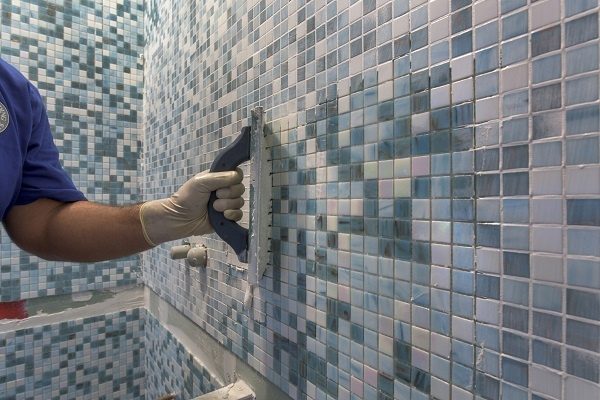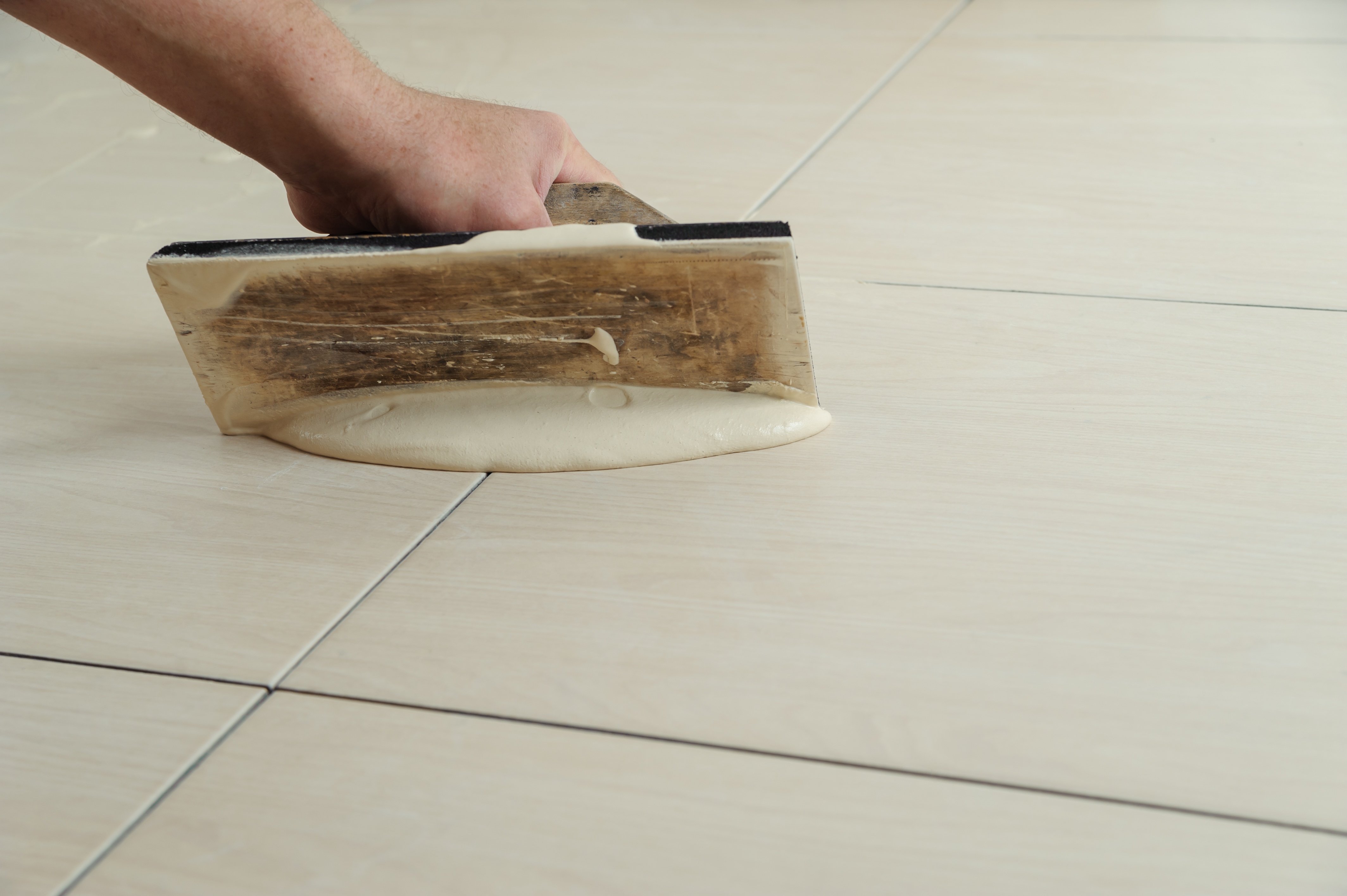Cement Grout
This is grout that has been used for many years and it hasn’t changed much, although there are some high-performance types available.
Sanded & Unsanded Grout
Sanded grout is classified as a cement grout that has 1/8” or larger grit to it. Unsanded grout is a cement grout with less than 1/8” grit.
Generally, unsanded grout is used for tile applications with narrower grout joints, from 1/16” to 1/8”. The additional structure of sanded grout is needed for wider grout joints from 1/8” to 5/8” and some even can go as wide as 1”.
Sanded and unsanded grouts are usually sufficient for residential uses but many homeowners and builders are moving completely away from it. There are so many options available now that remove many of the difficulties that come with traditional grout–it’s worth it for most people to go with at least a high-performance or epoxy grout.
High-Performance & Polymer Cement Grout
Grout designed for more demanding spaces, like basic commercial or high-traffic residences, must meet higher standards for shrinkage, water absorption, and strength. It is available in both sanded and unsanded.
Cement grout is now also available with added polymers, which does all the things high-performance grout can do but with the added benefits of what plastic can offer grout. The polymers are activated once the grout is mixed with water. The chemical reaction increases this grout’s water resistance and strength compared to traditional cement grouts. It also adds abrasion resistance and chemical resistance, which grouts that aren’t high-performance may not offer.
High-performance grout also offers better color consistency and resistance to efforescense (the salty look that sometimes comes along with cement products) that is a common problem with cement grouts.
Epoxy Grout
Epoxy grout is becoming the new standard in grout. It answers many of the concerns you might have with traditional grout. Epoxy grout must meet standards in water cleanability (how long water can be left on grout before it leaves a residue), shrinkage, sag, bond, strength, thermal shock, and chemical resistance.
The real strengths of epoxy grout are water absorption, strength, and chemical resistance. Epoxy absorbs about 50-times less water than traditional cement grouts, has double the strength, and chemical resistance that stands up to even the toughest environments.
You do have to clean epoxy grouts, but when you do they return to their original color rather than looking darker or keeping a grey-ish, dirty look.
Jim Whitfield, manager of Technical Services at Mapei told industry professionals, “Because epoxy grout is so tough, it wears extremely well. It doesn’t wear down over time and become a tile gutter—like cement grout can—where all the dirt and liquid and junk collects.”
Epoxy grout is a reactive grout. It comes in two parts that, when mixed together, begin a chemical reaction that gives epoxy all its best qualities. Mixing also starts the grout setting up so it has to be applied quickly in small batches, especially in the summer in hot temperatures. Even tile contractors can have difficulty with epoxy grout so it’s best to get a pro with experience installing with epoxy for best results.
100% Solids Epoxy
For extreme environments like commercial kitchens, dairies, meat processing plants, etc. where harsh chemical are used sometimes multiple times per day and left on the floor without rinsing, there’s an epoxy with enhanced performance. It does everything better plus it is fast curing, unlike regular epoxy and is resistant to high temperatures.
Single Component Grout
The name “single component” implies that this is an epoxy grout that doesn’t require mixing of two elements. However, it is not an epoxy. Technically, it is a urethane or an acrylic-silicone resin grout.
It shares many of the benefits of epoxy grout: it has excellent color consistency, doesn’t need to be sealed, resistant to breakage and chemicals, resists mold and mildew, is stain resistant, and doesn’t effloresce.
Once exposed to the air, it begins to set up. It comes in a bucket with a lid that seals when closed. That means that the whole bucket doesn’t have to be used at once as epoxy does. It is a favorite because it is easier to use than epoxy.
Pros & Cons
|
Cement Grout Pros |
Cement Grout Cons |
|
Suitable for most applications: indoors, outdoors, residential, commercial, dry, wet, submerged |
May be vulnerable in high-impact, high-traffic environments |
|
Easy to work with |
May deteriorate when exposed to acid or alkali compounds |
|
Suitable for just about any width grout joint |
Susceptible to inconsistent color due to inconsistent drying |
|
Very forgiving, most installers are very familiar with it, good choice for DIY |
Subject to efflorescence (salty look can be a part of any cement-based product) |
|
Sets up faster than epoxy but curing takes longer |
Not highly stain or chemical resistant |
|
Costs four-times less than epoxy |
Requires more equipment like tools and sponges because it the grout is hard on them |
|
Can be sealed to offer better protection from water, chemicals, mold, mildew, bacteria |
Porous material that can allow water to seep down into the grout and cause mold, mildew, or bacterial growth under the surface of the grout |
|
Epoxy Grout Pros |
Epoxy Grout Cons |
|
Low porosity so mildew, mold, or bacteria cannot get beneath the surface |
Sealer can compromise safety and effectiveness of epoxy grout and should not be used |
|
Resistant to stains, abrasions, breakage |
Epoxy must be mixed and used appropriately or it will not offer benefits like easy cleanability and strength |
|
Easily cleaned, best choice for light colored grouts |
Limited working time once the grout has been mixed and must be mixed in small batches |
|
Resistant to chemicals; good for commercial, industrial, and heavy commercial |
Light colors can yellow if exposed to sunlight |
|
Best choice for environments where harsh chemicals are used such as healthcare, commercial kitchens, schools |
Costs more than cement grouts |
|
Consistent color |
May take longer to apply than cement grouts and is more difficult to work with |
|
Less costly maintenance than cement grout |
Can degrade when in contact with chemical substances |
|
Single Component Grout Pros |
Single Component Grout Cons |
|
Low porosity so mildew, mold, or bacteria cannot get beneath the surface |
Sealer can compromise safety and effectiveness of single component grout and should not be used |
|
Resistant to stains, abrasions, breakage |
Not for use with irregularly shaped tile such as pebble type tile |
|
Easily cleaned, best choice for light colored grouts |
Not for use in steam showers or submerged conditions like pools, fountains |
|
Resistant to chemicals |
Is sensitive to both cold and hot temperatures during installation |
|
Easier to work with than epoxy grout |
Costs more than cement grouts |
|
Consistent color |
May take longer to apply than cement grouts and may be more difficult to work with |
|
Less costly maintenance than cement grout |
Can degrade when in contact with chemical substances, not for industrial uses |
With the right tile grout, you’ll love your tile! There’s a type of grout for every situation. It’s just a matter of finding the right one.
Get more advice about grout at your nearest Daltile location.




